|
This
picture gallery summarizes the invertebrates found on top of beachrock
at Playa Estacion, Puerto Penasco, Sonora, Mexico.
It should
be used to complete lab activity 9.2.
|
Clibanarius
digueti
|
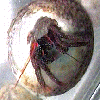 |
"Red-fingered
hermit crab"
| Phylum |
Arthropoda |
| Class |
Crustacea |
| Order |
Decapoda |
| Family |
Diogenidae |
|
| Morphology |
Red
in appearance, has an unexplained olive color phase. Light speckling
(blue) over the chelipeds and walking legs, antennaes are bright
red to orange, carapace is tan to gray. |
| Feeding |
Filter feeders
and scavengers |
| Defense |
Occupies the
shell of a dead snail |
| Reproduction |
Separate sexes.
Females brood eggs on pleopods until they hatch.
April - September, the male gives a chase over a 12 hour period
where the female is rotated, jiggled, tickled, and finally,
seduced. |
| Habitat |
In the mid and
upper intertidal zones, sandy short habitats with rock outcrops
or shell debris, mangrove swamps, under boulders and rock surfaces. |
| Distribution |
Lower Pacific
Baja and throughout the Gulf of California |
| Other |
Most common
hermit crab of the Gulf of California.
Gregarious
at low tide forming clusters of up to 700 individuals. Disperse
when the tide is changing. |
|
|
Paguristes
anahuacus
|
 |
"Blue-eyed
hermit crab"
| Phylum |
Arthropoda |
| Class |
Crustacea |
| Order |
Decapoda |
| Family |
Diogenidae |
|
| Morphology |
Cream
colored hermit crab with hairy, equal sized claws, and blue
tipped antennae. Young have blue eyes. |
| Feeding |
Filter feeders
and scavengers |
| Defense |
Occupies the
shell of a dead snail |
| Reproduction |
Separate sexes.
Females brood eggs on pleopods until they hatch. |
| Habitat |
Under boulders
and on the surfaces of rocky shores in the lower intertidal,
in tidepools and in the shallow subtidal |
| Distribution |
Gulf of California |
| Other |
Second most
abundant rocky shore hermit crab in the Gulf of California.
Gregarious. |
|
|
Eriphia
squamata
|
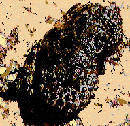 |
"Lumpy-clawed
Crab"
| Phylum |
Arthropoda |
| Class |
Crustacea |
| Order |
Decapoda |
| Family |
Xanthidae |
|
| Morphology |
Its
body (carapace) is usually 1-2 inches wide. It is mottled gray
to green and its legs are banded with black. |
| Feeding |
Feeds at night.
Forages for worms, algae and smaller crabs. |
| Defense |
Large claws
that can pinch. Will defend its territory savagely. Hides during
the day in holes or crevices. |
| Reproduction |
Males pass spermatophores
to females during copulation. Females carry fertilized eggs
under abdomenal flap. Hatchlings are zoea larvae that develop
in the plankton. |
| Habitat |
Occurs in great
numbers in the lower midintertidal zone of rocky shores. |
| Distribution |
Ranges from
upper Gulf to Ecquador and Galapagos Islands. |
| Other |
One of the most
common crabs - very territorial. |
|
|
Tetraclita
squamosa
|
 |
"Thatched
barnacle"
| Phylum |
Arthropoda |
| Class |
Crustacea |
| Order |
Thoracica |
| Family |
Tetraclitidae |
|
| Morphology |
A
large barnacle, 3/4 - 1 inch in diameter, conical, dull red
to gray or white. May live singly or in large clumps. Uses a
very strong "glue" to attach themselves to rocks. |
| Feeding |
Uses its feather-like
feet to sweep through the water and trap small particles of
food. It then retreats inside the shell to deposit the food
into its mouth. Feeds on both plants and animals (omnivore). |
| Defense |
May close off
its shell in case of predators or lack of water. |
| Reproduction |
Simultaneous,
cross-copulating hermaphrodites. Hatchlings are nauplius larvae
that develop in the plankton. |
| Habitat |
Common on exposed
rocks in higher intertidal zones. May also be found on turtles,
boat bottoms or other floating objects. |
| Distribution |
Puerto Penasco,
Puertecitos, Gonzaga Bay and Los Angeles Bay. |
| Other |
Empty barnacle
shells have a vital roll in the community by providing a protected
place where smaller organisms may take refuge. "Glue"
has been studied for possible application in denistry. |
|
|
Heliaster
kubinijii
|
|
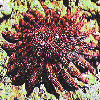
|
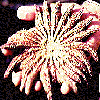 |
"Gulf
sun star"
| Phylum |
Echinodermata |
| Class |
Asteroidea |
| Order |
Forcipulata |
| Family |
Heliasteridae |
|
|
| Morphology |
A
pinkish-lavender seastar with black and green mottling, and
19 to 25 rays (starts life with 5 but adds rays as it matures).
Diameter is 2.5 to 8 inches. |
| Feeding |
An indiscriminate
top carnivore that prefers barnacles and small bivalves but
will eat snails, chitons, small crabs and other invertebrates. |
| Defense |
Tough, spiny
skin. |
| Reproduction |
Separate sexes
and spawning. Spawn in early spring. |
| Habitat |
On and under
rocks in the intertidal |
| Distribution |
Baja California,
throughout the Gulf of California, south to Nicaragua |
| Other |
The most common
starfish in the Gulf of California until 1978 when a massive
die off occurred. The Gulf sun star has since made a come back
but is still relatively rare. |
|
|
Othilia
tenuspina
|
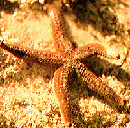 |
"Black-tipped
starfish"
| Phylum |
Echinodermata |
| Class |
Asteroidea |
| Order |
Spinulosa |
| Family |
Echinasteridae |
|
| Morphology |
Brownish-gray
with dark red-black tipped rays, the ventral side is yellowish-orange.
On the rays are small spines. |
| Feeding |
They invert
their stomachs, engulf their prey, and begin the digestion process
while their stomach is still outside their body. |
| Defense |
A creamy fluid
is secreted from pores in the rays when the animal is disturbed. |
| Reproduction |
A synchronized
release of sperm and eggs into the water. This is triggered
by the previous release of a chemical substance, called a pheromone,
into the water, signaling everyone to get ready for the "big
day". |
| Habitat |
Found on rocks
at the low tide level where there is some current. |
| Distribution |
Northern Gulf
of California, sporadically in the southern Gulf |
| Other |
Can regenerate
into a whole animal if at least 1 arm and 1/5 disk is present. |
|
|
Polyclinum
laxum
|
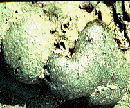 |
"Black,
colonial tunicate"
| Phylum |
Chordata |
| Class |
Ascidiacea |
| Order |
Enterogena |
| Family |
Polyclinidae |
|
| Morphology |
Generally
forms a smooth, raised colony, dark brown to black, with yellow
to white individuals arranged in oval or circular groups. Usually
5 - 10 cm across. Individually they are transparent, stiff,
and are covered by a jellylike tunic. |
| Feeding |
Filter small
particles from the water using a sticky, basket-like pharynx. |
| Defense |
Produce distasteful
biochemicals |
| Reproduction |
Produce planktonic
"tadpole" larvae that have chordate characteristics. |
| Habitat |
Live on the
surfaces or undersides of rocks |
| Distribution |
Gulf of California |
| Other |
Common inhabitant
of Puerto Penasco. |
|
|







